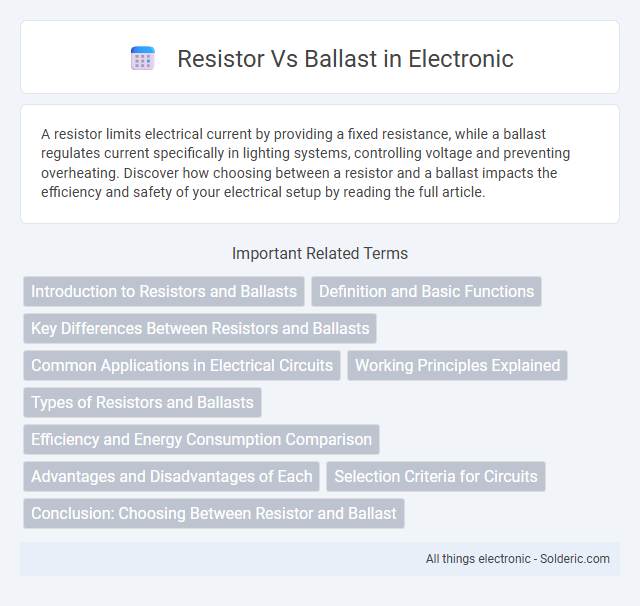A resistor limits electrical current by providing a fixed resistance, while a ballast regulates current specifically in lighting systems, controlling voltage and preventing overheating. Discover how choosing between a resistor and a ballast impacts the efficiency and safety of your electrical setup by reading the full article.
Comparison Table
| Feature | Resistor | Ballast |
|---|---|---|
| Function | Limits electrical current in a circuit | Regulates current and voltage in discharge lamps |
| Application | Used in various electronic circuits | Used in fluorescent and HID lighting systems |
| Operation | Provides fixed resistance | Controls current dynamically based on load |
| Component Type | Passive electrical component | Electromechanical or electronic device |
| Current Control | Static, fixed current limitation | Adaptive current regulation |
| Voltage Regulation | No voltage regulation | Provides voltage stabilization |
| Energy Efficiency | Lower efficiency due to heat dissipation | Higher efficiency with proper current control |
| Typical Usage | Basic circuits, signal conditioning | Lighting ballasts, motor starters |
Introduction to Resistors and Ballasts
Resistors regulate electrical current by providing a specific resistance value to protect circuits and control voltage levels, essential for various electronic applications. Ballasts function primarily to stabilize current in gas discharge lamps, such as fluorescents, preventing excessive current flow and ensuring consistent light output. Understanding the distinct roles of resistors and ballasts helps you optimize circuit performance and safety in your electrical designs.
Definition and Basic Functions
A resistor is an electrical component designed to limit current and drop voltage within a circuit by providing a precise amount of resistance measured in ohms. A ballast is a specialized device used primarily in lighting systems to regulate the current flow to lamps, ensuring stable operation and preventing damage from electrical surges. While resistors provide simple current control, ballasts combine resistance and inductance to manage and stabilize high-intensity discharge and fluorescent lamp functions.
Key Differences Between Resistors and Ballasts
Resistors regulate current flow by providing a fixed resistance, while ballasts control current in gas discharge lamps by limiting voltage to maintain stable light output. Resistors dissipate energy as heat regardless of current fluctuations, but ballasts adjust to voltage changes, ensuring lamp safety and longevity. Understanding these key differences helps you select the appropriate component for electronic circuits or lighting applications.
Common Applications in Electrical Circuits
Resistors are commonly used in electrical circuits to limit current, divide voltages, and protect sensitive components, especially in low-power applications such as signal processing and general electronics. Ballasts are primarily employed in fluorescent and HID lighting systems to regulate current flow and provide the necessary starting voltage, ensuring stable lamp operation. Unlike standard resistors, ballasts handle high voltage spikes and maintain consistent current in gas-discharge lamps, making them essential for lighting control circuits.
Working Principles Explained
A resistor limits electrical current by converting excess energy into heat, providing a fixed resistance in a circuit. A ballast regulates current in gas discharge lamps by controlling the voltage and preventing overheating or damage. Understanding these working principles can help you choose the right component for stable and safe electrical operation.
Types of Resistors and Ballasts
Resistors come in several types, including fixed resistors like carbon film, metal oxide, and wirewound, as well as variable resistors such as potentiometers and rheostats, each designed for specific resistance and power dissipation needs. Ballasts are primarily classified into magnetic ballasts, which use inductors to regulate current in fluorescent and HID lamps, and electronic ballasts that utilize high-frequency circuits for improved energy efficiency and reduced flicker. The selection between resistors and ballasts depends on their application: resistors control voltage and current in general circuits, while ballasts are specialized for maintaining stable current in lighting systems.
Efficiency and Energy Consumption Comparison
Ballasts regulate current in fluorescent and HID lamps with higher energy efficiency compared to resistors, which dissipate excess energy as heat and cause significant power loss. Electronic ballasts improve energy consumption by operating lamps at optimal voltage and frequency, reducing wasted electricity and extending lamp life. Resistive ballasts lead to increased energy consumption due to continuous power dissipation, making electronic or magnetic ballasts preferable for minimizing electricity costs.
Advantages and Disadvantages of Each
Resistors offer precise control of current with simple design and low cost but generate significant heat and waste energy, reducing efficiency. Ballasts regulate current in fluorescent lamps efficiently, preventing damage and prolonging lamp life, yet they are bulkier, more expensive, and may cause flickering or humming noises. Choosing between resistors and ballasts depends on application-specific needs for energy efficiency, cost, thermal management, and device longevity.
Selection Criteria for Circuits
Resistors are selected for circuits primarily based on resistance value, power rating, and tolerance to ensure precise current control and voltage division. Ballasts, often used in fluorescent lighting circuits, are chosen for their ability to regulate current under varying voltage conditions and provide stable operation over time. The selection criteria for ballasts emphasize starting voltage, current regulation, and compatibility with the specific lamp type and operating frequency.
Conclusion: Choosing Between Resistor and Ballast
Selecting between a resistor and a ballast depends on your specific electrical application and performance needs. Resistors provide simple voltage control and current limitation in low-power circuits, while ballasts are essential for regulating current in gas discharge lamps and ensuring stable operation. Your choice should consider factors such as power efficiency, heat dissipation, and the type of load involved.
resistor vs ballast Infographic

 solderic.com
solderic.com